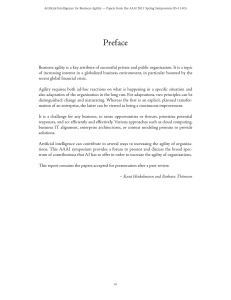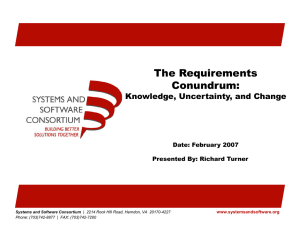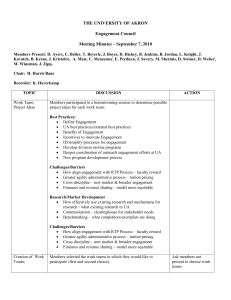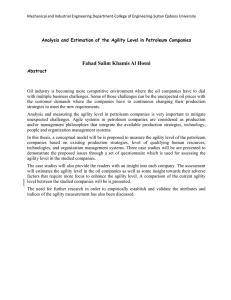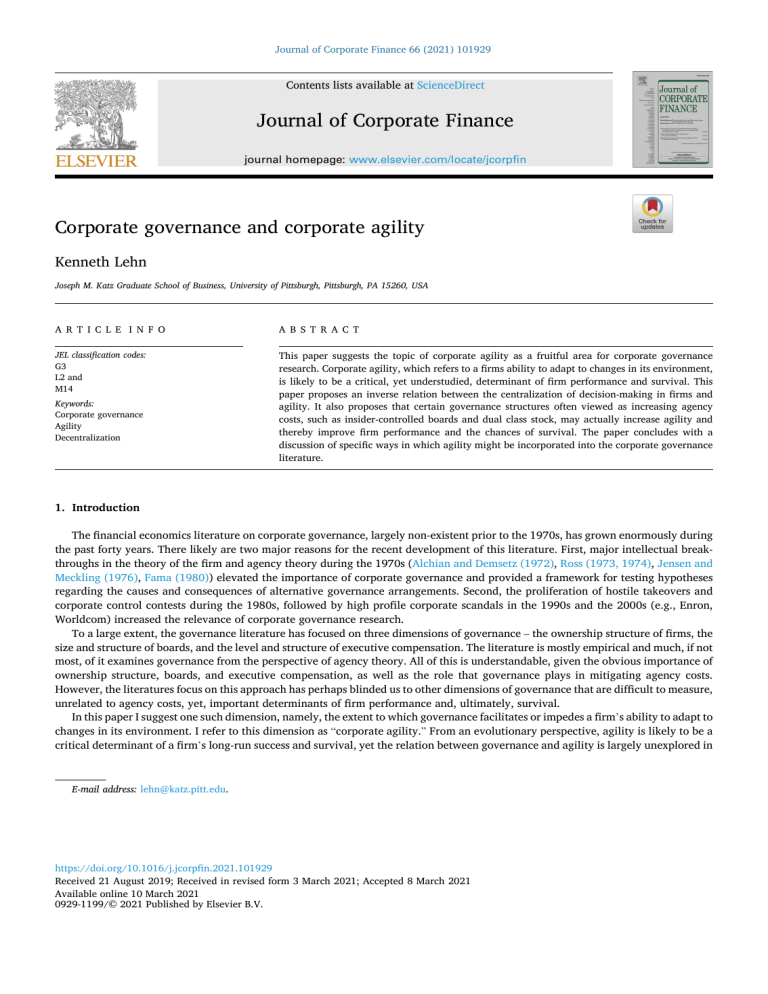
Journal of Corporate Finance 66 (2021) 101929 Contents lists available at ScienceDirect Journal of Corporate Finance journal homepage: www.elsevier.com/locate/jcorpfin Corporate governance and corporate agility Kenneth Lehn Joseph M. Katz Graduate School of Business, University of Pittsburgh, Pittsburgh, PA 15260, USA A R T I C L E I N F O A B S T R A C T JEL classification codes: G3 L2 and M14 This paper suggests the topic of corporate agility as a fruitful area for corporate governance research. Corporate agility, which refers to a firms ability to adapt to changes in its environment, is likely to be a critical, yet understudied, determinant of firm performance and survival. This paper proposes an inverse relation between the centralization of decision-making in firms and agility. It also proposes that certain governance structures often viewed as increasing agency costs, such as insider-controlled boards and dual class stock, may actually increase agility and thereby improve firm performance and the chances of survival. The paper concludes with a discussion of specific ways in which agility might be incorporated into the corporate governance literature. Keywords: Corporate governance Agility Decentralization 1. Introduction The financial economics literature on corporate governance, largely non-existent prior to the 1970s, has grown enormously during the past forty years. There likely are two major reasons for the recent development of this literature. First, major intellectual break­ throughs in the theory of the firm and agency theory during the 1970s (Alchian and Demsetz (1972), Ross (1973, 1974), Jensen and Meckling (1976), Fama (1980)) elevated the importance of corporate governance and provided a framework for testing hypotheses regarding the causes and consequences of alternative governance arrangements. Second, the proliferation of hostile takeovers and corporate control contests during the 1980s, followed by high profile corporate scandals in the 1990s and the 2000s (e.g., Enron, Worldcom) increased the relevance of corporate governance research. To a large extent, the governance literature has focused on three dimensions of governance – the ownership structure of firms, the size and structure of boards, and the level and structure of executive compensation. The literature is mostly empirical and much, if not most, of it examines governance from the perspective of agency theory. All of this is understandable, given the obvious importance of ownership structure, boards, and executive compensation, as well as the role that governance plays in mitigating agency costs. However, the literatures focus on this approach has perhaps blinded us to other dimensions of governance that are difficult to measure, unrelated to agency costs, yet, important determinants of firm performance and, ultimately, survival. In this paper I suggest one such dimension, namely, the extent to which governance facilitates or impedes a firm’s ability to adapt to changes in its environment. I refer to this dimension as “corporate agility.” From an evolutionary perspective, agility is likely to be a critical determinant of a firm’s long-run success and survival, yet the relation between governance and agility is largely unexplored in E-mail address: lehn@katz.pitt.edu. https://doi.org/10.1016/j.jcorpfin.2021.101929 Received 21 August 2019; Received in revised form 3 March 2021; Accepted 8 March 2021 Available online 10 March 2021 0929-1199/© 2021 Published by Elsevier B.V. Journal of Corporate Finance 66 (2021) 101929 K. Lehn the literature.1 This topic is especially relevant in rapidly changing environments, such as the one firms face today with recent changes in technology and consumer preferences, as well as the present-day Covid-19 pandemic. Certain attributes of governance that often are viewed as increasing agency costs, such as insider-controlled boards and multiple classes of common stock with different voting rights, might well have the beneficial effect of fostering corporate agility. It is likely that, for some firms, governance structures that promote agility, even at the expense of higher agency costs, improve overall firm performance and increase the chances of survival.2 The paper is structured as follows. In Section 2, I suggest the topic of corporate agility as a worthwhile topic for corporate governance scholars and present anecdotal evidence suggesting that it is an important determinant of firm performance. Section 3 discusses the relation between “specific” knowledge, a concept developed by Jensen and Meckling (1992), corporate agility, and corporate governance. Section 4 contains concluding comments and thoughts about future research on corporate agility. 2. Corporate agility In his seminal paper on evolution and economic theory, Alchian (1950) uses the concepts of evolution and natural selection to analyze economic systems. He shows that the predictions of traditional economic theory hold without the assumption that firms are “profit maximizers.” He emphasizes that, just as with biological evolution, the economic environment “adopts” survivors, regardless of their motivation, and survivors are selected based on relative profits, not “maximum” profits. Alchian (1950) discusses the process of adaptive behavior and states that in a changing environment “trial and error becomes survival or death.”3 In his concluding comments, Alchian (1950) states that “what really counts is the various actions actually tried, for it is from these that ’success’ is selected, not from some set of perfect actions.”4 Taking this perspective, the long-run performance and survival of firms depends on their ability to adapt to changes in their business environments, i.e., on their “agility.“The value of agility for a given firm is likely to depend on the speed with which its environment is changing. For example, the value of agility is likely to be greater for companies facing rapidly changing technologies, such as Amazon, Google, Facebook, and Apple, than it is for firms operating in more stable environments, such as regulated utilities. Likewise, the value of agility is likely to change over time as the business environment changes. The dramatic changes in technology, consumer preferences, and ways in which consumers and businesses shop during the past decade have likely increased the value of corporate agility for firms in a wide range of industries, including, among others, retail, publishing, consumer packaged goods, and financial services. A large amount of anecdotal evidence suggests the importance of corporate agility as a determinant of firms’ success and survival. Arguably, the retail industry has been affected by technological change and the shift to online shopping as much or more than other industries. Anecdotally, there are many recent examples of retailers whose operating and stock price performance declined sub­ stantially in part because of their alleged sluggishness in adapting to the changes in the retail environment. For example, during the past several years, Macy’s Inc., a traditional “bricks and mortar” department store chain, reported weak operating performance, closed hundreds of stores, and suffered large declines in its stock price. A Wall Street Journal reported that Macy’s had “poached a senior eBay Inc. executive and streamlined its top management in an effort to speed up decision-making at the department store chain.”5 In discussing the streamlining of management, Macy’s chief executive officer (“CEO”) states “we had a lot of decision makers at the table, and we weren’t as fast as we needed to be.”6 In addition to Macy’s, the performance of other traditional retailers has suffered allegedly because they were slow to adapt to the environmental changes, as shown in the following quotes: a. In an article discussing a management change at Kohl’s, The Wall Street Journal states that “the department-store chain, like its competitors, was grappling with how to adapt to the shift to online shopping.”7 b. Reporting on a disappointing earnings release by Hennes & Mauritz (“H&M"), The Wall Street Journal states that “the downbeat results underscore … the cost of the Swedish company’s sluggishness to embrace digital”8 and “H&M has lagged behind com­ petitors in the move to online sales.”9 c. In discussing the demise of Sears Holding Co., an industry executive states that its “strategy of underinvesting in stores and selling off assets starved capital and management from the retail business, leaving it unable to respond and adapt to the needs of the evolving consumer and marketplace.”10 1 The topic of corporate agility is related to, but distinct, from the topic of flexibility options, which, of course, has been studied extensively in the literature. Because agility refers to the speed with which a firm adapts to changes in its environment, one can think of agile firms as exercising flexibility options more efficiently than other firms. Put differently, if two firms have identical flexibility options but one is agile and the other is not, the agile firm, with speedier decision-making, is more likely to optimally exercise the options than the less agile firm. 2 I am not suggesting that mitigation of agency costs and agility are mutually exclusive, only that some governance structures might entail a tradeoff between the two. 3 Alchian (1950), at 219. 4 Id., at 220. 5 Kapner (August 21, 2017). 6 Id. 7 Kapner and Lublin (September 26, 2017). 8 Chopping and Chaudhurst (September 28, 2017). 9 Id. 10 Peterson (May 21, 2017). 2 Journal of Corporate Finance 66 (2021) 101929 K. Lehn d. In announcing a possible sale of its convenience stores unit, the CEO of Kroger Co. states that “we need to move faster on digital.”11 e. Mickey Drexler, former chairman and CEO of Gap Inc. and J Crew Group Inc., states “I’ve never seen the speed of change as it is today … If I could go back 10 years, I might have done some things earlier.”12 f. Reporting on Aeropostale, Inc.’s bankruptcy filing, The Post and Courier states that “since the great recession, many teen chains have suffered because of fierce competition from the likes on online players and fast-fashion retailers such as Forever 21. But they’re also wrestling with seismic changes in shopping behavior … Aeropostale has been slow to adapt to these changing times.”13 These are but a few of many similar quotes that have appeared regularly in the business press during the past several years describing the difficulties that firms in retail, as well as other industries, have had adapting to changes in the business environment. The ongoing Covid-19 pandemic has called additional attention to the importance of corporate agility during periods in which there is an abrupt change in the business environment. A recent Wall Street Journal article, describing how companies are diverting capital spending from IT hardware to cloud services during the pandemic, quotes Crawford Del Prete, chief executive officer (“CEO”) of International Data Corporation, stating that “as a result of Covid-19, there’s a premium on agility, and the cloud and associated services can give enterprises a high degree of agility.”14 Another recent Wall Street Journal article, titled “To Fight Coronavirus, a Johnson Controls Executive Urges Agility,” profiles Lisa Roy, head of sales at Johnson Controls, who emphasizes the importance of adapting to changes in the business environment induced by the pandemic.15 In an article describing how railroads have adopted strategies to enhance agility during the pandemic, Lance Fritz, CEO of Union Pacific, states that “we have for a long time thought and worried about trying to build agility into our decision making and reaction time … we are way better at that today.”16 The topic of corporate agility also has been featured prominently in proxy contests during the past several years. For example, in Trian Partners’ proxy contest with Procter & Gamble in 2017, it states that “disruptive and existential threats are impacting the entire consumer packaged goods industry, including changes in technology and consumer behavior,”17 and that “P&G must act with the greatest possible urgency to address the market share it is losing to both its peers and smaller local competitors, who are adapting to industry changes more effectively than P&G (italics added).”18 The proxy filing goes on to say that “structural and organizational bu­ reaucracy prevents management from identifying and responding to commercial opportunities in a timely manner, hinders product innovation and dampens sales growth”19 and that “Trian has made the decision to nominate Mr. Peltz for election to the Board at the 2017 Annual Meeting so that he can act as a catalyst for faster and more significant change at P&G (italics added).”20 David Taylor, P&G’s CEO countered by saying that “we continue to make changes to our organization design, culture, and accountability … today P&G is more nimble (italics added).”21 Mr. Taylor cites a UBS analyst as saying that “we are encouraged by P&G’s continued emphasis on agility (italics added), its focus on improving digital competency, and its willingness to look externally to sup­ plement and enhance internal capabilities”22 and a Barclays analyst states that P&G “is in fact making progress on its articulated turnaround plan or stated more simply, it is not standing still (italics added).”23 In sum, from an evolutionary perspective, corporate agility is likely to be an important predictor of firm performance and survival, especially during periods of rapid environmental change, and anecdotal evidence suggests that it is. Alchian (1950) writes that the economist “can predict the more adoptable or viable types of economic interrelationships that will be induced by environmental change … like the biologist, the economist predicts the effects of environmental changes on the surviving class of living organisms.”24 Along these lines, little is known about the role corporate governance plays in the natural selection process that separates firms into “winners” and “losers” when there is significant environmental change. In the next section I suggest that through its effect on corporate agility, corporate governance likely plays an important role in this process. 3. Specific knowledge, agility, and corporate governance Corporate governance, in effect, defines how decision rights are allocated among various stakeholders within organizations. Whereas the mitigation of agency costs plays an important role in determining how decision rights are allocated, other considerations also are likely to affect the allocation of these rights as well. One such consideration is the distribution of “specific” knowledge within organizations. The role played by knowledge in economic organizations was first identified by Hayek (1945), who discussed the issue in the 11 12 13 14 15 16 17 18 19 20 21 22 23 24 Haddon, 2017. Safdar, 2017. D’Innocenzio (May 3, 2016). Loten, 2020. Tita, 2020. Ziobro, 2021. https://www.sec.gov/Archives/edgar/data/80424/000090266417002944/p17-1517dfan14a.htm. Id. Id. Id. David S. Taylor, Letter to P&G Shareholders, August 14, 2017. Id. Id. Alchian (1950), at 221. 3 Journal of Corporate Finance 66 (2021) 101929 K. Lehn context of the efficacy of central planning versus decentralized price systems, not in the context of corporate governance. In his critique of central planning, Hayek (1945) emphasized the critical role that knowledge plays in resource allocation, noting that knowledge “is not given to anyone in its totality.”25 He elaborates on this, stating: “ … the economic problem of society is mainly one of rapid adaptation to changes in the particular circumstances of time and place … decisions must be left to the people who are familiar with these circumstances, who know directly of the relevant changes and of the resources immediately available to meet them. We cannot expect that this problem will be solved by first communicating all this knowledge to a central board which, after integrating all knowledge issues its order. We must solve it by some form of decentralization.” In effect, Hayek (1945) recognizes that knowledge can be costly to transfer from those who possess it to those who have decision rights (i.e., the central planners in this case). His preference for decentralization is that it confers decision rights on those who possess the relevant knowledge. In a paper that is less known than their classic 1976 paper, Jensen and Meckling (1992) build on Hayek (1945)’s insight by examining how knowledge affects the tradeoff associated with centralized versus decentralized decision-making. They recognize that knowledge usually is diffused among various stakeholders within organizations and that, as a general matter, it is important to “colocate” knowledge with decision-making. Jensen and Meckling (1992) point out that there are two ways to accomplish this: (i) knowledge can be transferred from those who possess it to those with decision rights or (ii) decision rights can be transferred to those who possess the knowledge. Within corporations, the former involves transferring knowledge from lower level employees to head­ quarters (i.e., centralized decision-making), while the latter involves transferring decision rights from headquarters to lower level employees (i.e., decentralized decision-making). To analyze the tradeoffs associated with centralized versus decentralized decision-making, Jensen and Meckling (1992) distinguish between two types of knowledge – “specific knowledge,” which is costly to transfer, and “general knowledge,” which can be trans­ ferred at zero or low cost. Jensen and Meckling (1992) point out that transferring knowledge involves more than simply communi­ cating information, which they illustrate by stating that “the simple purchase of a physics book is not sufficient to transfer the knowledge to the purchaser (as evidenced by students who regularly pay thousands of dollars for help in acquiring such knowl­ edge).”26 For knowledge to be successfully transferred, the recipient must process and understand it, which depending on the nature of the knowledge, can take a long time. Given the importance of agility in rapidly changing environments, lengthy decision-making associated with the transfer of specific knowledge can be quite costly. Jensen and Meckling (1992) further depict the trade-off between centralized and decentralized decision-making by incorporating the role played by agency costs. Ignoring agency costs, it would appear that decision rights should be transferred to lower level employees who possess specific knowledge, given the high cost of transferring this knowledge to headquarters. Jensen and Meckling (1992) note, however, that the objective functions of lower level employees may be more provincial that that of headquarters, leading them to use decision rights to promote the interests of their business units instead of promoting the interests of the firm as a whole. Hence, under the Jensen and Meckling (1992) model, the optimal degree of centralization involves a tradeoff between the agency costs associated with decentralization and the costs of transferring specific knowledge associated with centralized decision-making. During periods of rapid environmental change, centralized decision-making is likely to be at a disadvantage vis-à-vis decentralized decision-making. Adaptation to the changing environment involves the use of specific knowledge about how the environment is changing and that knowledge is likely to reside at divisional levels, not at headquarters. An exception to this conjecture is the case in which headquarters already possesses the relevant specific knowledge, which likely will be the case for firms that are disrupting the business environment, i.e., firms that are the sources of the changing business environment, such as many technology companies today. But for other firms, the cost of transferring specific knowledge about changes in markets, technology, consumer behavior, and so forth, from divisional levels to headquarters is likely to be sufficiently large as to place centralized decision-making at a disadvantage. Insofar that agile decision-making is especially valuable during these periods, decentralized (i.e., speedier) decision-making is likely to be rewarded over centralized (i.e., slower) decision-making. This conjecture is consistent with anecdotal evidence related to Trian’s proxy contest with Procter & Gamble. Trian alleged that Procter and Gamble’s centralized organizational structure hindered innovation by Gillette, which Procter and Gamble had acquired in 2005. Trian noted that managers in the Gillette unit were restricted from investing in e-commerce by headquarters, resulting in a loss of market share to Dollar Shave Club and Harry’s, two of Gillette’s major online competitors. Trian (2017) stated that the proposals for a “proactive and aggressive direct-to-consumer response was quickly ‘shut down’ by corporate and the local sales team"27 and that “P&G would have benefitted from more decentralized and less homogenized thinking.”28 In short, the framework provided by Jensen and Meckling (1992), suggests that firms with centralized decision-making are likely to fare worse than firms with decentralized decision-making during periods of rapid environmental change, owing to the fact that centralization hinders agility, whereas decentralization facilitates it. And, in the context of Alchian (1950), it is not that decentral­ ization necessarily leads to the “right” decision, i.e., “the value-maximizing” decision, but rather that it leads to a decision. As quoted 25 26 27 28 Hayek (1945), at 519. Jensen and Meckling (1992), at 5. Trian (2017), at 43. Id. 4 Journal of Corporate Finance 66 (2021) 101929 K. Lehn previously, Alchian (1950) states that “trial and error becomes survival or death,”29 and that “what really counts is the various actions tried, for it is from these that ‘success’ is selected.”30 Insofar that centralized decision-making inhibits trial and error, because of the costs of transferring specific knowledge, a rapidly changing environment is likely to adopt firms that have decentralized decisionmaking structures. The framework provided by Jensen and Meckling (1992) also has implications for our analysis of governance structures that are viewed by some academics and policy makers as “weak” because they purportedly increase instead of mitigate agency costs. For example, there is a frequent presumption in the literature that insider-controlled boards are inherently bad for outside shareholders because insiders can make decisions that benefit themselves at the expense of outside shareholders. During the past 40 years, listing standards adopted by stock exchanges, often at the prodding of the Securities and Exchange Commission, and legislation passed by Congress (e.g., Sarbanes-Oxley) reflect the view that boards controlled by outside directors, as opposed to insiders, are more likely to promote the interests of outside shareholders. This view appears to be predicated on the assumption that boards should be constructed in such a way as to minimize agency costs. However, the costs of transferring specific knowledge from corporate managers to outside directors is likely to inhibit corporate agility, especially during times of rapid environmental change, because it requires time, perhaps considerable time, for outside directors to process and understand the relevant specific knowledge. Absent regulatory constraints, it might well be the case that companies with insider-controlled boards would be “adopted” by rapidly changing envi­ ronments, given that insider-controlled boards are more likely to make speedier decisions than boards controlled by outside directors. Similarly, many academics and policy makers take the view that multiple classes of common stock with different voting rights are inherently “bad” for outside shareholders because insiders can use their voting control to promote their interests at the expense of outside shareholders. While this may be the case, the argument by itself, ignores a likely countervailing benefit associated with such governance structures, namely that they are likely to foster corporate agility as the controlling shareholders, who typically are the top managers, can make decisions more quickly, i.e., without the consent, in some cases, of outside shareholders. This may explain in part why dual class structures are common among technology companies, such as Facebook, Alphabet, and Netflix, where the value of corporate agility is likely to be high. The fact that these companies go public with dual class structures (and that, a la Jensen and Meckling (1976), insiders bear the costs associated with “sub-optimal” governance structures at the time of initial public offerings) suggests that, for some companies, there are net benefits associated with dual class structures, which perhaps relate to their effect on corporate agility. 4. Concluding comments The significant growth in the corporate governance literature during the past 40 years has advanced our knowledge of the causes and consequences of different governance mechanisms, to a large extent, from the perspective that governance is intended to mitigate agency costs. Notwithstanding the advances that have been made, this paper argues that the literature has largely ignored an important consideration, namely, the extent to which different governance structures promote or impede corporate agility, which may be a higher order determinant of long-run performance and survival for many firms than the mitigation of agency costs. The integration of corporate agility into the governance literature appears to be a good area for future research. Advances in textual analysis hold promise for allowing us to measure corporate agility. In addition, industry studies that focus on industry-specific measures of agility are likely to enrich our understanding of the relation between corporate governance, performance, and sur­ vival. For example, in the retail industry, what is the relation between corporate governance structures and the speed with which bricks and mortar firms adapted to online commerce? Were retail firms that filed for bankruptcy during the past several years slower to adapt to the rapid environmental change, and if so, did their governance structures play a role in their ability to adapt? Addressing these questions, for the retail industry, as well as others, is likely to enrich our understanding of the relation between corporate governance, firm performance, and survival. One topic that appears promising is the relation between corporate agility and (i) the size of boards and (ii) the structure of boards. Linck et al. (2008) and Lehn et al. (2009) find that firms with higher growth opportunities tend to have smaller boards, presumably because such firms value nimble decision-making, which is facilitated by smaller boards. This leads to a testable prediction – are firms with smaller boards more agile? Returning to the retail industry, have retailers with smaller boards responded more quickly to the growth of e-commerce during the past decade or so? In addition, have the board sizes of retail firms become smaller in recent years, as the value of agility has increased? Examining the relation between board structure and agility also is a promising area for research. As discussed above, insidercontrolled boards are likely to be more agile than outsider-controlled boards, owing to the specific knowledge that inside directors possess vis-à-vis outsider directors. However, this information asymmetry can be mitigated by the choice of outside directors. Recognizing that outside directors serve in advisory, as well as monitoring, roles (Adams et al. (2010)) and that specific skills and knowledge of outside directors are particularly valued by different firms (Miletkov et al. (2017)), it is feasible that firms operating in rapidly changing environments select outside directors that can advise the firm in ways that promote agility. For example, in the retail industry, have the characteristics of outside directors changed over time? Specifically, as e-commerce has grown, are there more outside directors with Silicon Valley/digital backgrounds on the boards of retail firms? And, relatedly, have retail firms with such outside directors adapted more quickly to e-commerce? 29 30 Alchian (1950), at 219 Alchian (1950), at 220. 5 Journal of Corporate Finance 66 (2021) 101929 K. Lehn Finally, the relation between capital structure and agility is another potential topic for future research. It is widely recognized in the literature that one of the advantages of corporate debt is that it constrains managers from overinvesting, which is especially relevant for firms that generate significant free cash flows but have limited growth opportunities (Jensen (1986)). However, this advantage can become a disadvantage if there is a shock that requires firms to make new investments in order to remain competitive, or even survive, in a rapidly changing environment. Anecdotally, Toys R Us, widely viewed as failing to adapt to e-commerce, filed for Chapter 11 bankruptcy in 2017 and then Chapter 7 bankruptcy in 2018. The company had been acquired in a highly leveraged private equity transaction in 2005, which raises an interesting question – did the high level of debt hinder Toys R Us from making investments in technology that were necessary to compete in an increasingly digital industry? More generally, have retailers with low debt-to-value ratios adapted more quickly to e-commerce than retailers with high debt- to-value ratios? In conclusion, the topic of corporate agility, and its relation to corporate governance and corporate financial policies is, in my opinion, a promising area for future research. Acknowledgements I am grateful for comments that I received from David Denis, Diane Denis, Shawn Thomas, Chad Zutter, Irena Hutton, and an anonymous referee. References Adams, Renee B., Hermalin, Benjamin E., Weisbach, Michael S., 2010. The role of boards of directors in corporate governance: a conceptual framework and survey. J. Econ. Lit. 48 (1), 58–107. Alchian, Armen A., 1950. Uncertainty, evolution, and economic theory. J. Polit. Econ. 58 (3), 211–221. Alchian, Armen A., Demsetz, Harold, 1972. Production, information costs, and economic organization. Am. Econ. Rev. 62 (5), 777–795. Chopping, Dominic, Chaudhurst, Saabira, September 28, 2017. H&M hit by Discounting, Slowness to Embrace Digital. Wall Street J. https://www.wsj.com/articles/h-m-hit-by-discounting-slowness-to-embrace-digital-1506593207. D’’Innocenzio, May 3, 2016. 4 Reasons Aeropostale Lost its Cool. In: The Post and Courier https://www.postandcourier.com/business/reasons-aeropostale-lostitscoo/article_3eba2718-40b4-53ae-80e4-0e93a27oda31.html. Fama, Eugene F., 1980. Agency problems and the theory of the firm. J. Polit. Econ. 88 (2), 288–307. Haddon, Heather, October 11, 2017. Kroger weighs sale of convenience stores. Wall Street J. https://www.wsj.com/articles/kroger-weighs-sale-of-conveniencestores-1507737959. Hayek, Friedrich A., 1945. The use of scientific knowledge in society. Am. Econ. Rev. 35 (4), 519–530. Jensen, Michael C., 1986. Agency costs of free cash flow, corporate finance, and takeovers. Am. Econ. Rev. 76 (2), 323–329. Jensen, Michael C., Meckling, William H., 1992. Specific and general knowledge, and organizational structure. http://papers.ssrn.com/ABSTRACT=6658, also published in. In: Werin, Lars, Wijkander, Hans (Eds.), 1992 Contract Economics. Blackwell, Oxford. Jensen, Michael C., Meckling, William H., 1976. Theory of the firm: managerial behavior, agency costs and ownership structure. J. Financ. Econ. 3, 305–360. Kapner, Suzanne, August 21, 2017. Macy’s Hires eBay Executive Amid Management Shakeup. Wall Street J. https://www.wsj.com/article/macy’s-hires-ebayexecutive-amid-management-shakeup-1503348301. Kapner, Suzanne, Lublin, Joann S., September 26, 2017. How a Starbuck’s Veteran Took the Helm at Kohl’s. Wall Street J. https://wsj.com/articles/kohls-ceo-toretire-next-year-1506434071. Lehn, Kenneth, Patro, Sukesh, Zhao, Mengxin, 2009. Determinants of the size and composition of US corporate boards: 1935-2000. Financ. Manag. 38 (4), 747–780. Linck, James S., Netter, Jeffry M., Yang, Tina, 2008. The effects and unintended consequences of the Sarbanes-Oxley act on the supply and demand for directors. Rev. Financ. Stud. 22, 3287–3328. Loten, Angus, April 16, 2020. Companies Devote Shrinking Tech Budgets to Cloud, AI. Wall Street J. https://www.wsj.com/articles/companies-devote-shrinking-techbudgets-to-cloud-ai-11587029400?mod=searchresults&page=1&pos=1. Miletkov, Mihail K., Poulsen, Annette B., Babajide Wintoki, M., 2017. Foreign independent directors and the quality of legal institutions. J. Int. Bus. Stud. 48, 267–292. Partners, Trian, 2017. RevitalizeP&GTogether. Peterson, Hayley, May 21, 2017. Sears’ CEO Blames the Media for Company’s Decline – But His Obsession with Wall Street Set it Up for Failure. Bus. Insid. https:// www.businessinsider.com/how-eddie lambert-set-sears-up-to-fail-2017-5. Ross, Stephen, 1973. The economic theory of agency: the Principal’s problem. Am. Econ. Rev. 63 (2), 134–139. Ross, Stephen, 1974. The economic theory of agency and the principle of similarity. In: Balch, M.D., McFadden, Daniel, Wu, Shih-yen (Eds.), Essays on Economic Behavior under Uncertainty. Amsterdam: North-Holland. Safdar, Khadeeja, May 24, 2017. J.Crew’s Mickey drexler confesses: i underestimated how technology would upend retail. Wall Street J. https://www.wsj.com/ articles/j-crews-big-miss-how-technology-transformed-retail-1495636817. Tita, Bob, April 13, 2020. To fight coronavirus, a johnson controls executive urges agility. Wall Street J. https://www.wsj.com/articles/to-fight-coronavirus-ajohnson-controls-executive-urges-agility-11586770201?mod=searchresults&page=1&pos=1. Ziobro, Paul, 2021. Railroads prepare for quick turnaround. Wall Street J. https://www.wsj.com/articles/railroads-prepare-for-turnaround-11587663541? mod=searchresults&pages=1&pos=3. 6
